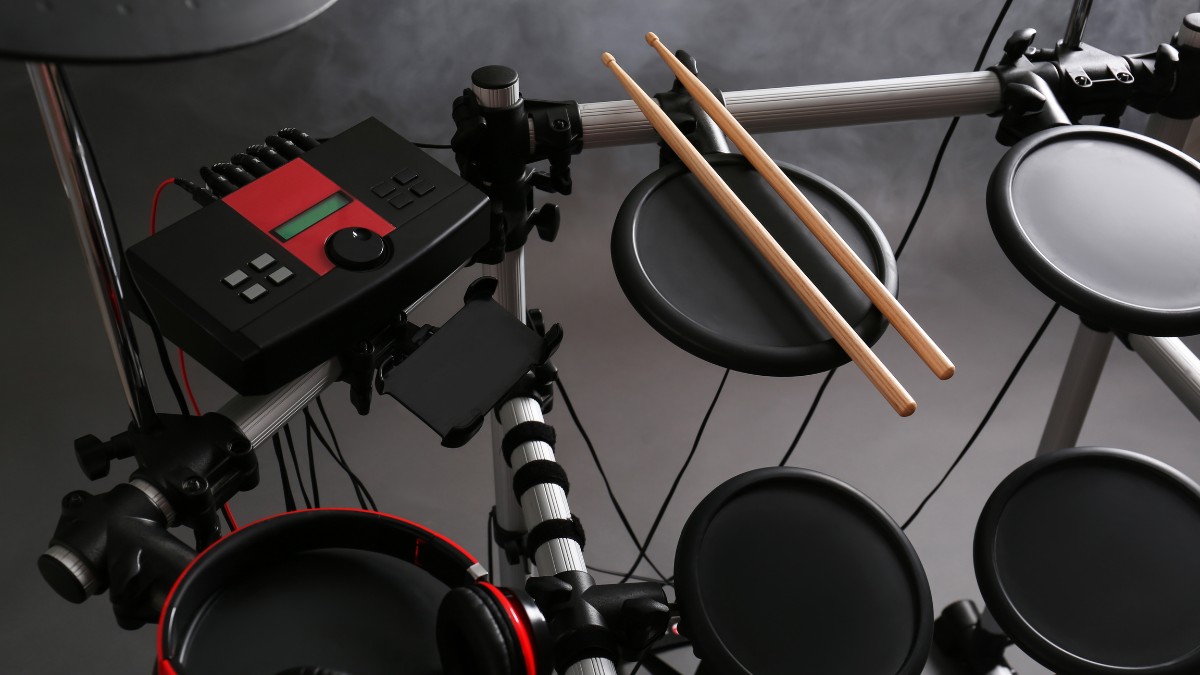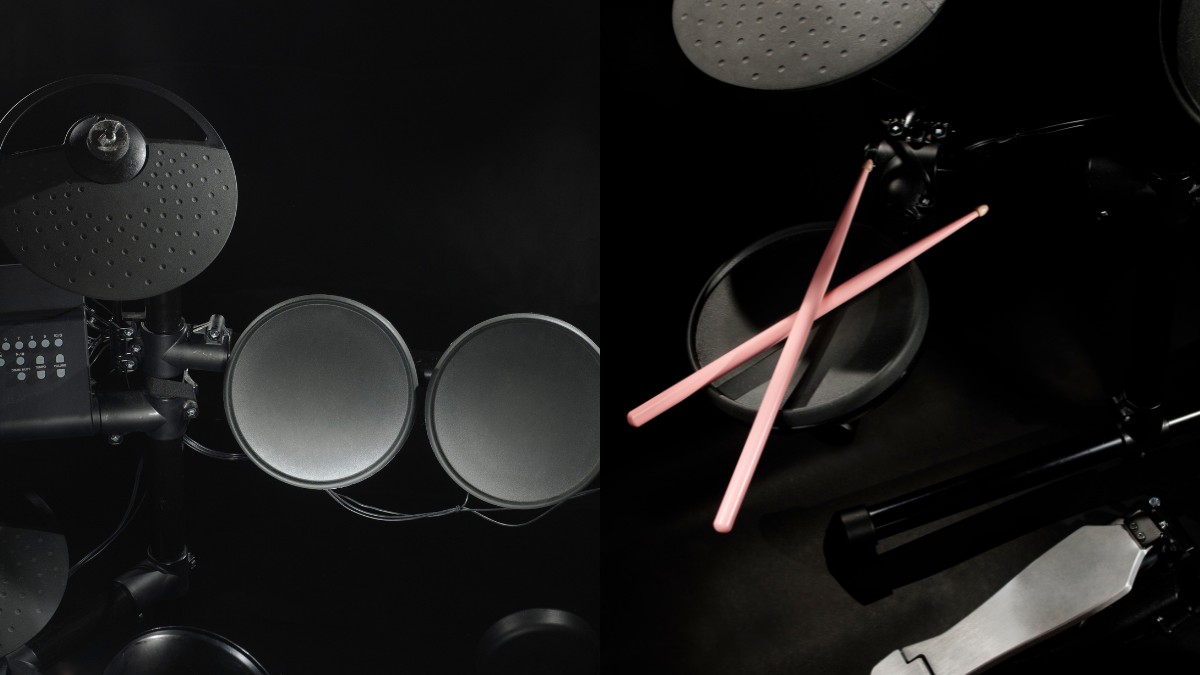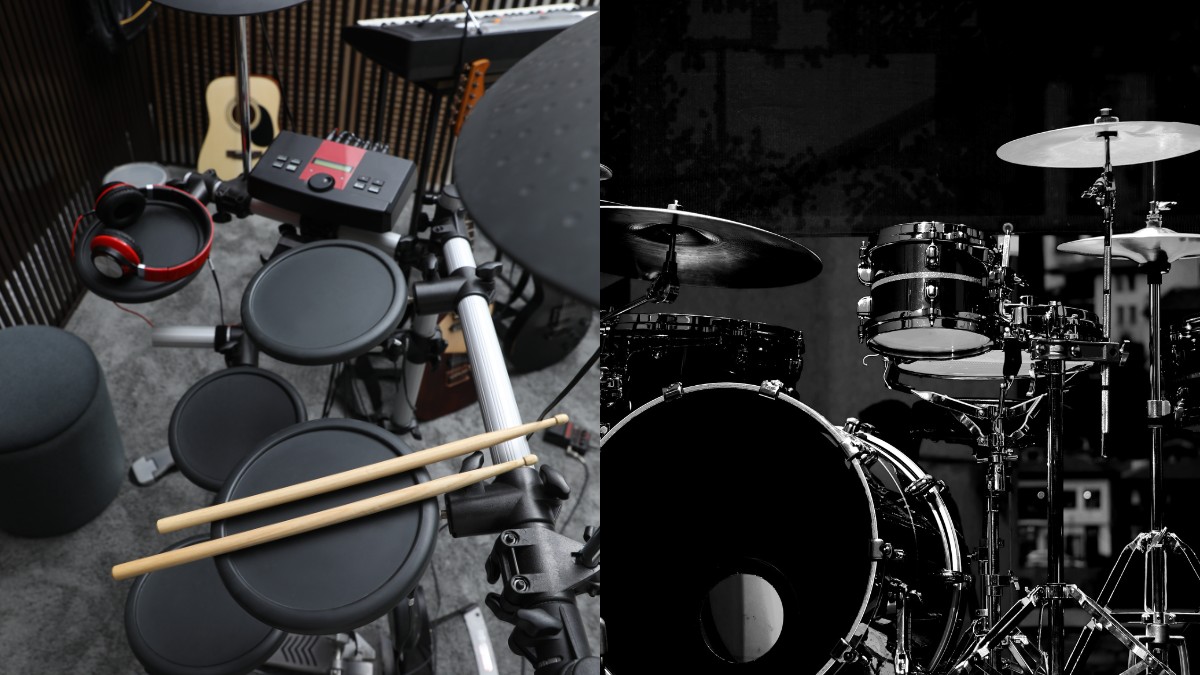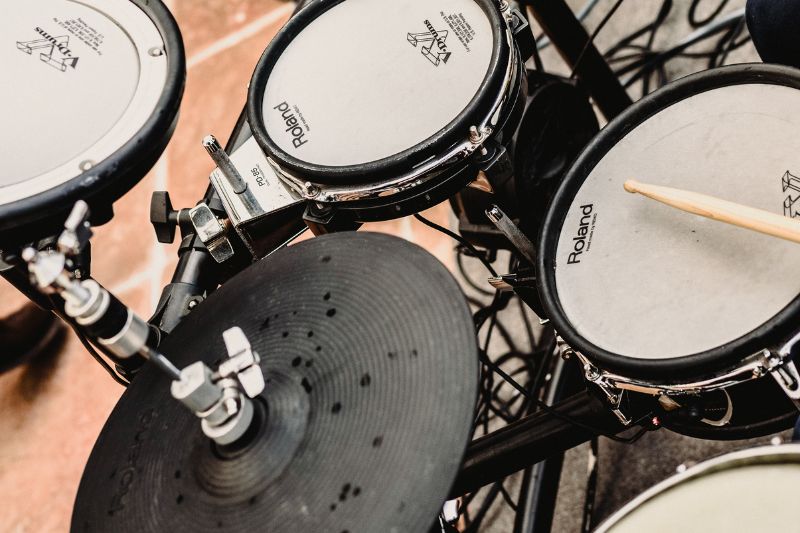The Ultimate Guide to Hybrid Drums (2024)
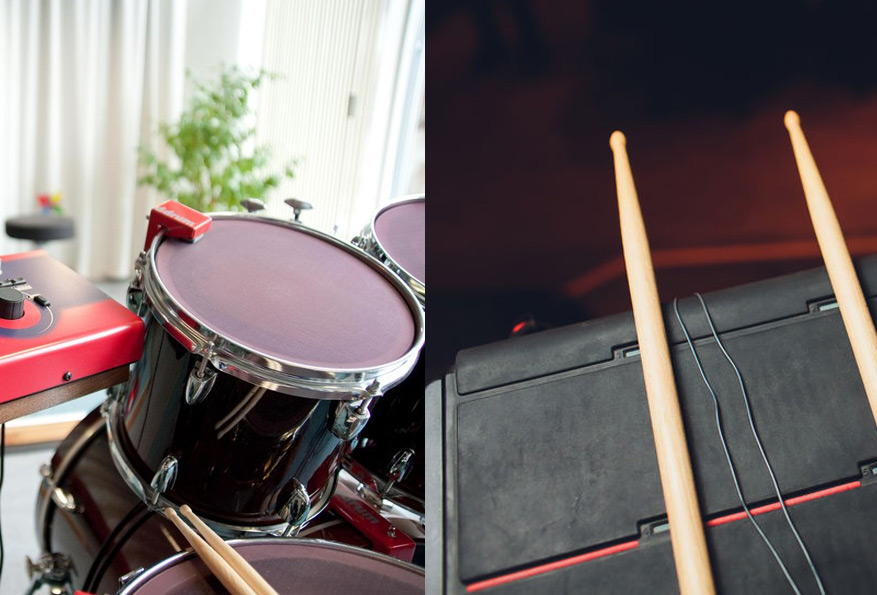
A hybrid drum set is any combination of acoustic drums and electronic drums. We’re going to explain the different options available to drummers to easily create a hybrid drum set.
You do not need to be a music production guru to set up hybrid drums, you just need to understand a few basic points.
How do you add electronic elements to your drum set? Here are a few options:
- Mount a sample pad or percussion pad next to your drum set (such as a Roland SPD-SX)
- Attach drum triggers to your drums, which trigger drum samples every time you hit a drum.
- Use rubber/mesh drum pads and position them in different parts of your kit.
- Use an electronic kick pad along with a standard kick drum pedal.
- Hybrid cymbals (which are more advanced than rubber cymbals).
Many studio productions of modern music genres use sounds that are not possible for a drummer to recreate simply by using an acoustic drum set. A hybrid drum set brings a whole world of sound possibilities, while still allowing you to enjoy using acoustic drums.
We’re going to talk through each of the 5 different methods to create a hybrid drum set. You can put some of these together or just use them individually. It’s completely up to you.
Contents
1. Include Sample or Percussion Pads
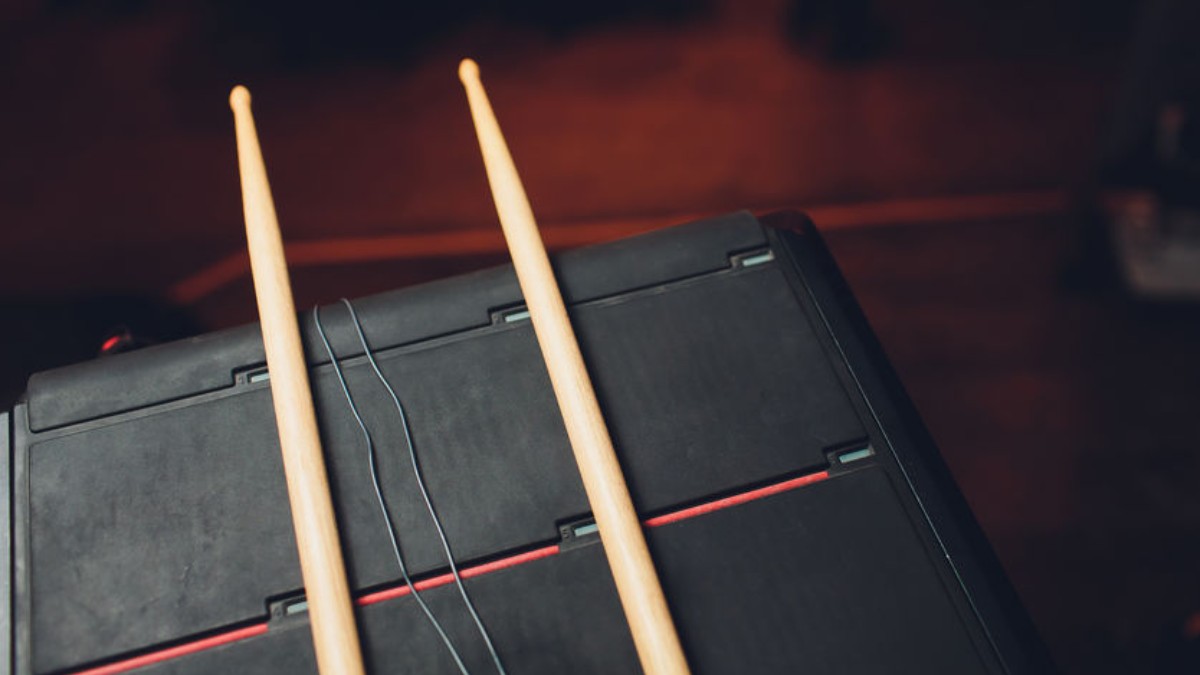
![]() Sample and percussion pads are perhaps the easiest way to go electronic.
Sample and percussion pads are perhaps the easiest way to go electronic.
You can keep your acoustic set exactly the way it is and simply purchase a drum pad such as the Roland SPD-SX or Yamaha DTX Multi-12 that can be played on the side.
These pads include simple audio jack outputs, which can be easily connected to the sound engineers mixing desk for live performances.
These are also particularly easy to use because they do not require separate drum modules to operate, as both the ‘brain’ and pads are in one ready-to-go box.
To learn more about sample and percussion pads, see our guide on the best electronic drum pads for your own needs and budget.
2. Use Drum Triggers
A Prerequisite: Drum Module (or Sample Pad)

We need to discuss drum modules before we continue with the next options for creating your hybrid drum set. These are the ‘brain’ of electronic drums. You may have multiple pads or cymbals on your set, but they all connect with the drum module in order to trigger sounds. The drum module is what you would connect to the mixing desk or interface.
The Roland TM-2 Trigger Module is an example of such a device. There are many other drum modules on the market, including cheap options as well as much higher end modules such as the new TD-50 drum module.
Alternatively, if you have just a few triggers or pads, you can hook them into the back of your sample pad (such as Roland Octapad, Roland SPD-SX, Alesis Strike multipad, etc).
Drum Triggers
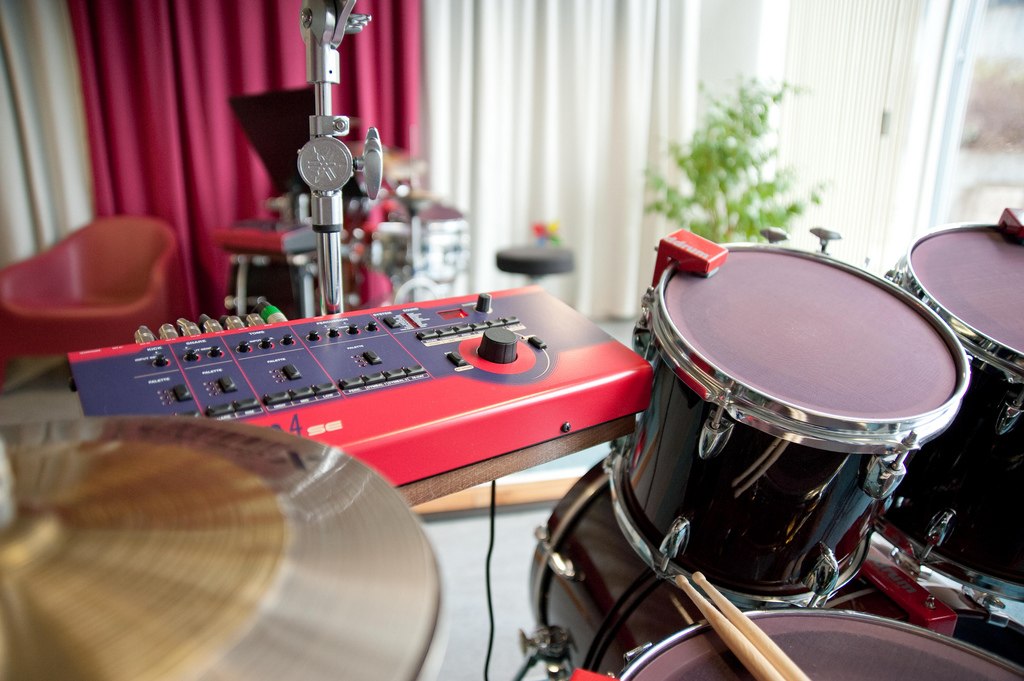
Drum Triggers simply attach to the rim of your acoustic drum and lightly press against the drum head. You then connect the trigger to a drum module by a wire.
When you hit your drum head then the trigger will pick up the sound and then trigger a sound on the drum module. These are incredibly simple to set up. You can generally adjust the sensitivity of the trigger based on your needs.
Drum triggers are a very useful solution to either replace or supplement bad drum miking. For example, in a live performance, you could mic up your acoustic drum but also trigger an electronic drum sound on top of this.
Using a drum trigger you could create a layered punchy sound on your kick drum without having to rely on the miking of your drum kit or the sound engineer.
This is an incredibly useful tool for pop or electronic drummers, or those that regularly play in small venues where sound may be unreliable. Using a good drum module you can pitch and alter the electronic sound so that it exactly suits your acoustic drum.
Alternatively, you could overlay a completely different sound like claps on top of your snare.
Dual triggers detect separate hits to the drum rim. For example, you could trigger a clap sound whenever you hit the snare rim. Very cool!
Such an example is the Roland RT-30HR Dual Zone Trigger.
Many metal drummers have been using triggers for years to increase the sound on their fast double-kick pedal strokes.
This has always been a controversial element in the heavy metal drumming community as some class it as ‘cheating’, but you would be surprised at how many metal drummers use this technique.
3. Drum Pads, Cymbal Pads, and Trigger Pads

![]() You can buy extra drum or cymbal pads and place them in convenient locations around your drum set.
You can buy extra drum or cymbal pads and place them in convenient locations around your drum set.
For example, you could buy a rubber or mesh pad and place it on a stand somewhere around your acoustic drum set (Roland V-Pad PDX-100 mesh drum pad pictured on the right). This could trigger a different cymbal sound, drum sound, or anything you want. You then connect this to the drum module.

![]() Another neat option is the Roland BT-1 Bar Trigger Pad (pictured on the right). This attaches to the rim of your drum and can serve as a neat little pad
Another neat option is the Roland BT-1 Bar Trigger Pad (pictured on the right). This attaches to the rim of your drum and can serve as a neat little pad
Also, most percussion pads such as the Roland SPD-SX include extra inputs for drum pads. So if you own one of these, you do not necessarily have to buy a separate drum module.
4. Kick Pads
Similar to the previous point, you could also connect a kick drum tower to your drum module or sample pad.
The roland kd-7 kick controller is a very nice option as it takes up very little space around your drum set. Most standard single kick drum pedals work with these.
5. Hybrid Cymbals
What’s one thing that most drummers complain about when it comes to electronic drums? It’s the cymbals. Cymbals are such subtle instruments that standard samples often don’t cut it.
Hybrid cymbals are a fantastic solution to this, which works via cymbal vibrations compared to rubber cymbal pads.
The Zildjian Gen16 cymbal is a good example of this, which include:
1) A low volume cymbal – a perforated cymbal with about an 80% reduction in volume.
2) A direct source pickup, which picks up the metal vibrations. So it’s quite different to a drum pad.
3) DCP – Digital Cymbal Processor. The vibration from the cymbal hit is sent to the DCP via a wire. You can store different versions of the cymbal sounds from these.
You then connect the DCP to an external amplifier or mixing desk.
It’s a little more complicated than using simple trigger pads, but it can give a very interesting sound.
Using Hybrid Drums with Software on Your Computer
You can connect your drum trigger module or sample pad with software on your computer using a MIDI connection (either via a MIDI cable or USB cable if your device supports it). You would generally use DAW software such as Ableton Live, GarageBand, Logic Pro, Cubase, etc)
This gives you a large array of options. You can trigger drum sample libraries such as Addictive Drums 2. You could also manipulate controls within your software such as starting a click track, moving onto the next track in your set, and even controlling light shows!
For more information, check out our article on how to record electronic drums to your computer. This includes a detailed section on MIDI with electronic drum sets. The same instructions apply to drum modules and sample pads.
Examples of Hybrid Drum Sets
Ben Barter
Have a quick look at the following video. This is Ben Barter, the drummer from Lorde. Ben plays an extremely hybrid drum set. In fact, this is edging much more towards the electronic, but you don’t have to go as extreme as this. Ben really nicely demonstrates the use of drum and percussion pads, drum triggers, and extra pads in one hybrid set up.
KJ Sawka
KJ Sawka, is the drummer from the bands Pendulum and Destroid. Look at this fantastic kit set up. He uses a combination of triggered heads and acoustic sounds.
If you look closely, you’ll see the triggers attached to the rims of each of the drums, and an electronic drum trigger module at the bottom left of the video. From the looks of it, he’s using Roland’s newest triggering technology, and they sound fantastic.
He’s even using some pitch automation on at least one of the e-drums too. Very inventive and interesting.
He’s a heavy user of Ableton Live, and has even created sample packs directly for use in that DAW.
Also, he’s a great drummer.
AFISHAL
Now for something completely different. AFISHAL is a drummer/DJ that has a massive following online. He uses his own fantastic electronic drum pad and light show setup. The pads are used as triggers to Ableton live on his laptop, which he uses to create a live drumming/DJ combo.
This is definitely the most inventive looking setup out of this list. This would be an incredibly fun kit to play on!
Brennan Benko
Listen to the tasty sound of this. With fantastically processed samples, he uses a kick trigger with a really punchy club 808 sound. Another user of the Roland SPD-SX, I think you’ll notice that’s a very common thing amongst great hybrid setups.
Great acoustic and electronic combinations here. Notice the microphone placement, and the tasty sound he’s getting from the rim shots. He’s still decided to go with the presence of an acoustic kick drum. Why wouldn’t he, it sounds amazing.
Caleb Breaux
Another very cool player of hybrid drum setups, Caleb is a drummer/producer that uses a very nice combination of gear as a drummer/producer.
He has put together a bunch of cool videos that you can check out on his Instagram. He often uses a small amount of drum pads, hats, and a Roland SPD-SX. He’s also a big fan of the fantastic Roland 404, a great old sampler that’s still as relevant as when it first came out.
It’s easy for drummers to feel like they’re stuck in the background, Caleb is a perfect example of someone that’s being in the limelight while also having a great time on his kit!
Camellia Akhamie Kies
Camellia Akhamie Kies is a professional drummer and DJ with a US military veteran background and big resume in music education. Originally born in the German City of Heidelberg (go there, visit the castle, it’s lovely… but hey, this isn’t a travel blog).
Camellia’s setups vary a lot depending on the context. In this example, she uses the powerful percussion pad capabilities of the Roland Octapad along with the sampling power of the Roland SPD-SX, a dream combination for those that have the budget!
She blends electronic pads, with acoustic drums, and percussion instruments. She also sometimes replaces her kick drum with a cajon (very useful for portability).
Summary
Those are the main methods to create a hybrid kit, fusing your acoustic and digital drumming together. I hope you learned something from this guide. If you have any questions please leave a comment below.
It’s easy to get lost in the standard formats of electronic drum sets, but some really amazing stuff can come out if you’re willing to experiment a bit and be creative.
After all, music is about expression, creativity, and performance.
You can start off small, such as using a few pads. Later on, you can really build on your knowledge, process effects and samples, use MIDI, drum triggers, etc!
Are you using any other techniques or methods in your hybrid drum set? Leave a comment below so we can include it in this guide.

